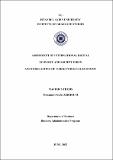DSpace Repository
ASSESSMENT OF INTERNATIONAL DIGITAL ECONOMY AND SOCIETY INDEX AND FORECASTING OF TURKEY’S DIGITAL ECONOMY
JavaScript is disabled for your browser. Some features of this site may not work without it.
| dc.contributor.author | MZERHOUNI, ohamed Noufal
|
|
| dc.date.accessioned | 2023-09-18T08:21:11Z | |
| dc.date.available | 2023-09-18T08:21:11Z | |
| dc.date.issued | 2022 | |
| dc.identifier.uri | http://hdl.handle.net/11547/10403 | |
| dc.description.abstract | This study assesses the International Digital Economy and Society Index (I DESI), which measures the progress of the digital economy, clusters countries, and forecasts their scores. First of all, because the initial criteria weights are chosen subjectively according to EU policy orientation, they were compared to new ones, generated using entropy method characterized by its objectivity. Then, the ranking model of the I-DESI is assessed by using the Entropy-based, the TOPSIS-based, and the Entropy-based TOPSIS models. Ranks agreement among the four models is tested using Kendall W. Afterword, in order to check the similarities of the EU countries, hierarchical and K-mean clustering methods are performed. At the end, forecasting of the I-DESI, by using Gompertz II model, is performed in order to compare Turkey’s forecasts by dimension to the forecasts of the I-DESI-45 countries average. The findings demonstrate that the Entropy method gives the highest weights to "Connectivity" and "Integration of Digital Technology and Business" dimensions, whereas the I-DESI scoring model gives it to "Connectivity" and "Human Capital". The Entropy method, on average, gives nearly double the weight to the "Use of Internet Services by Citizens" than to the "Digital Public Services", whereas the I-DESI scoring model gives both the same weight. Also, a very strong correlation exists between the I-DESI model and the TOPSIS-based and the Entropy-based models. While a moderate positive one is with the Entropy-based TOPSIS model. The four ranking models agree to a considerable extent. The differences found between the scoring model and the entropy means that countries (mostly non-EU) who are doing well in “Use of Internet Services” dimension, like Turkey, get penalized in the I-DESI computation as the subjectively fixed weight is almost half what the entropy generated. The correlation found between the four ranking models means the I-DESI model, even including the use of subjective criteria weights and viii aggregating using the score model is a similar model of scoring and ranking when compared to objective multi-criteria decision methods (Entropy and TOPSIS). The Kendall agreement between the four models means that they generate almost the same ranks. Recommendations could be used to adapt strategies for digital competitiveness. Such strategies should include: Scoring higher and faster in the I DESI in the future, requires giving more importance to two dimensions: Connectivity and "Human Capital", because they weight together 50%. Added to that, maintaining the rising performance of Use of Internet Services dimension, this strategy orientation will prove effective and straightforward: (i) Expanding the fixed broadband and increasing internet speed, (ii) Boosting trainings for people to acquire basic and advanced IT skills (word, spreadsheets, coding) and to increase the number of ICT graduates from educational institutions, (iii) Increasing the use of technology related to banking and shopping transactions and the number of internet users in rural areas in particular, (iv) Enhancing e-government services to comparable leading countries and making it possible to complete each step of key services completely online. | tr_TR |
| dc.publisher | ISTANBUL AYDIN UNIVERSITY INSTITUTE OF SOCIAL SCIENCES | tr_TR |
| dc.title | ASSESSMENT OF INTERNATIONAL DIGITAL ECONOMY AND SOCIETY INDEX AND FORECASTING OF TURKEY’S DIGITAL ECONOMY | tr_TR |
| dc.type | Thesis | tr_TR |
Files in this item
This item appears in the following Collection(s)
-
Tezler -- Thesis [3470]
